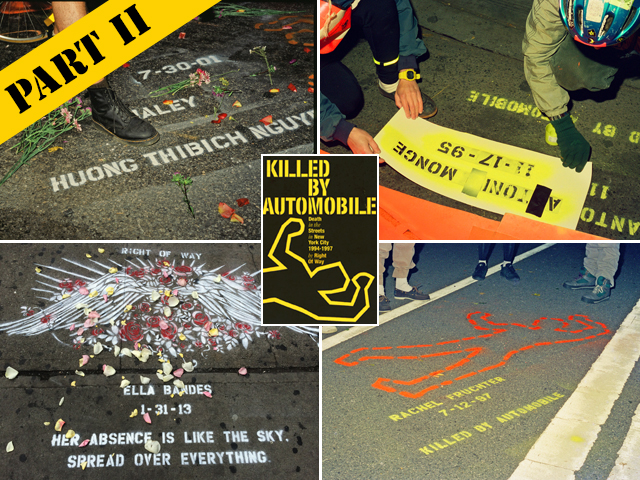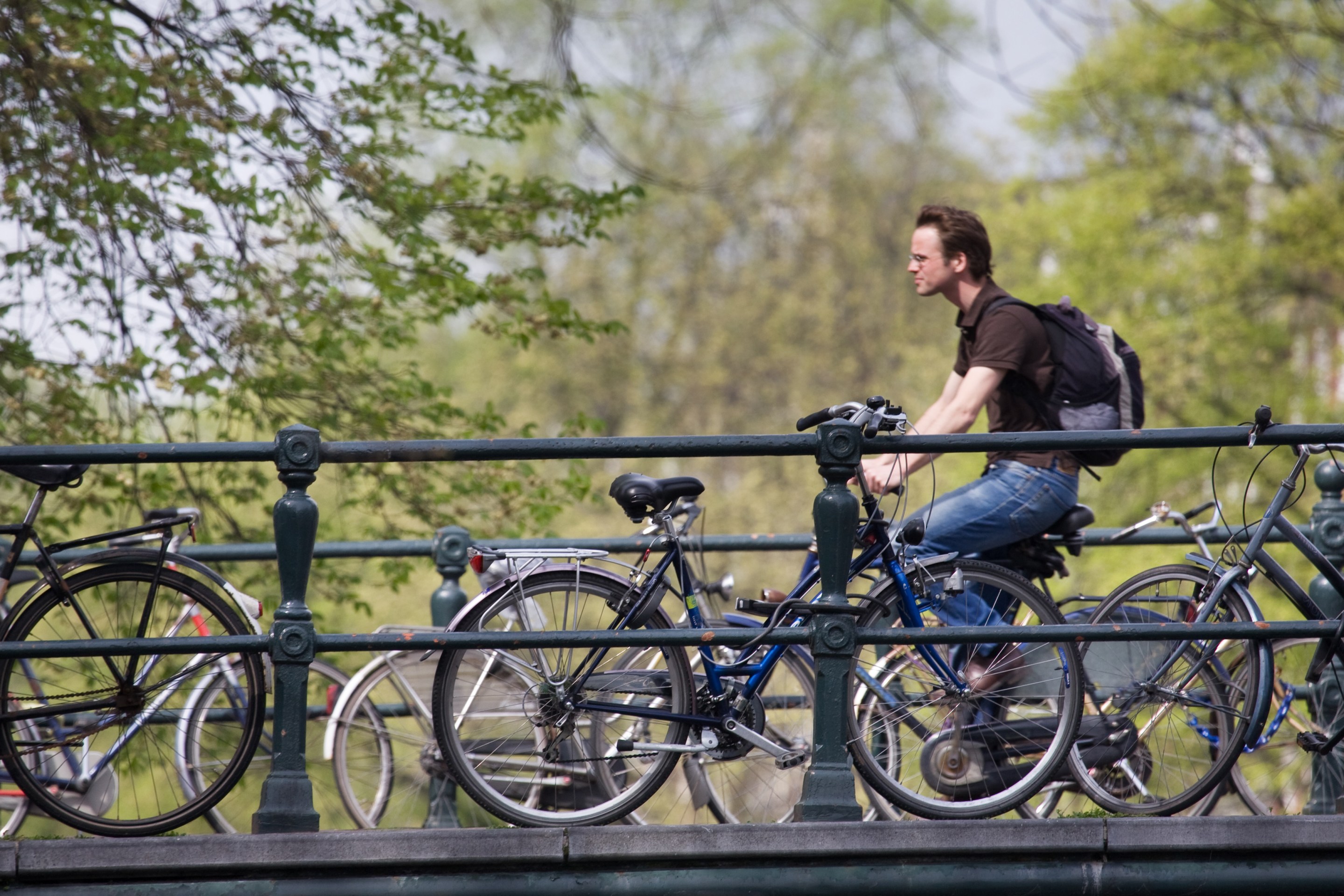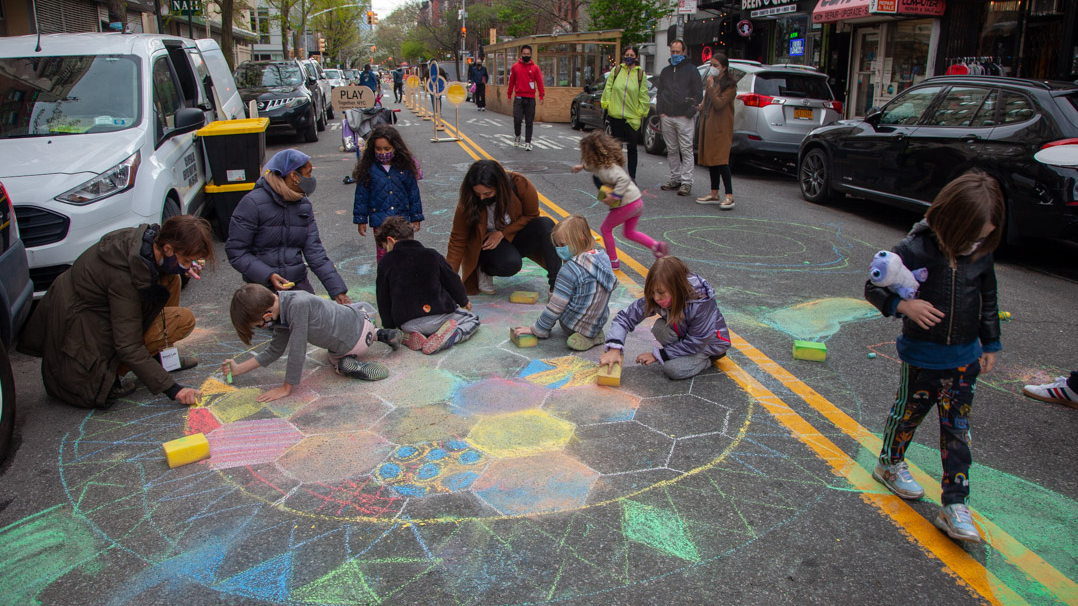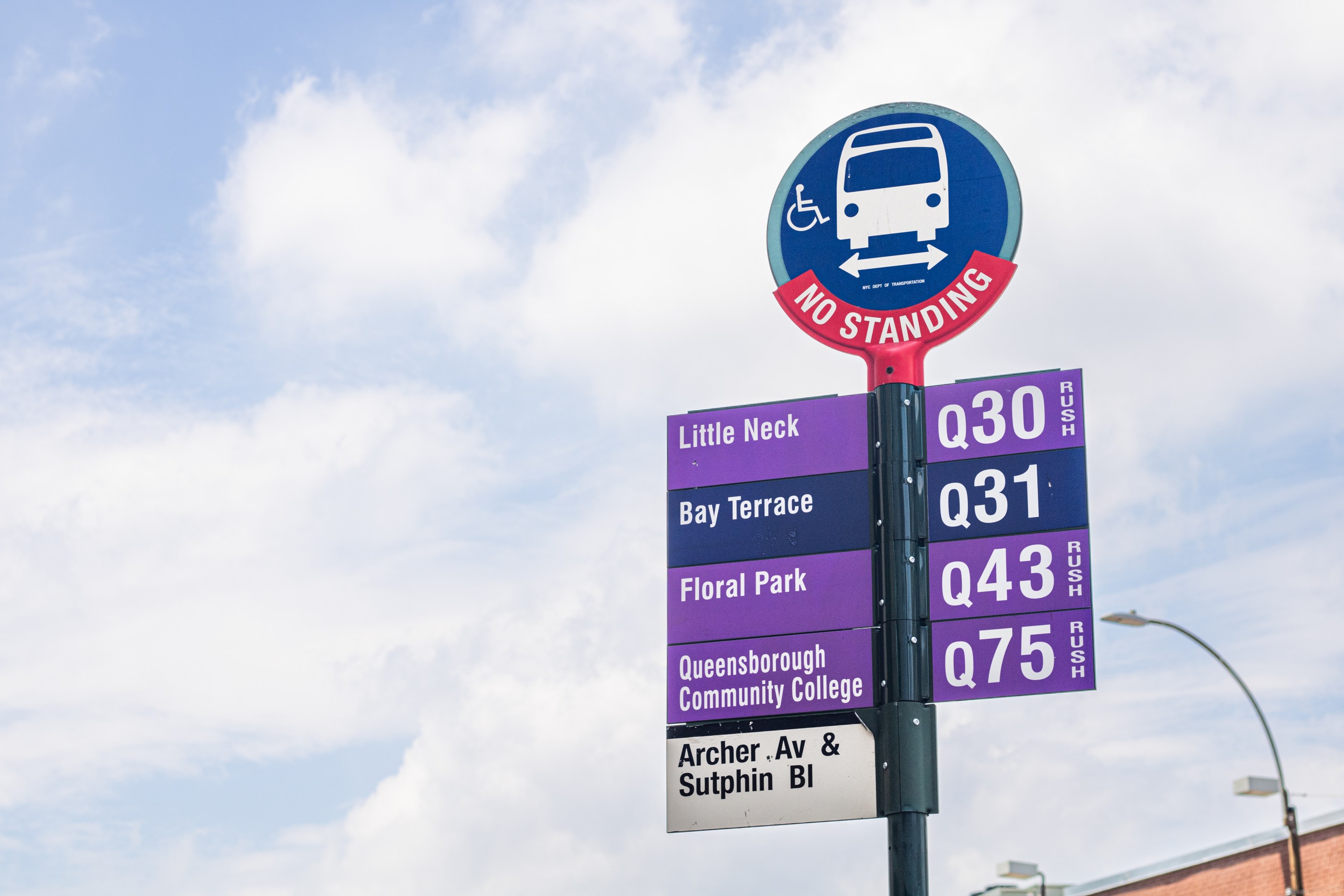Amid the bloodiest year in Mayor de Blasio’s Vision Zero, Streetsblog continues its seven-part series focusing on a key strand in the movement for livable safe streets, written by a central figure in that movement, Charles Komanoff. A former head of Transportation Alternatives, Komanoff 25 years ago launched a highly effective public awareness campaign calling out the daily carnage on New York City streets. Under the name “Right Of Way,” his group brought the brutal reality of pedestrian and cyclist deaths to the public eye in the form of high-visibility street actions (including one arrest). Part I, which ran on Monday, opened in December 1996. This installment focuses on initial media coverage of the movement.
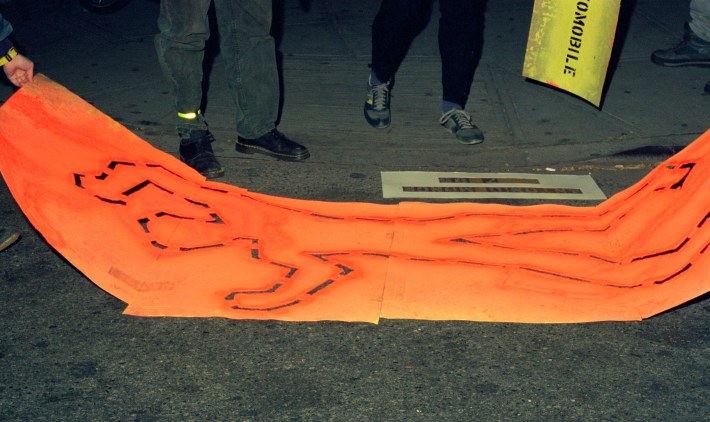
Right Of Way's December 1996 street stenciling kicked off a monthly routine: Comb the papers for accounts of fatal crashes. Gather somewhere and affix precut two-inch stencil letters and numerals onto cardboard. Load up the bike trailer and pedal into the night. Spray, shoot, move on. Out by 8 p.m., home by 11.
The tempo quickened with the arrival of spring, as the stenciling surfaced in a few neighborhood papers. Most of us were publicity-shy, but not Harris Silver, who originated the stenciling idea and produced the image that became flatso. Harris reached out to Clyde Haberman, a New York Times newsman who disdained city cyclists, but seemed attuned to pedestrians’ vulnerability to cars. Haberman profiled us in his April 25, 1997 column, Why the Streets Aren’t Safe: The Drivers.
His piece led, fittingly, with our stenciling of Jie Zhang:
Jie Zhang's fate comes to mind because of a grim tribute that some pedestrian advocates paid her the other night at the site where she was hit. In orange paint, they sprayed the outline of a human body on the sidewalk, with her name, date of death and the words “killed by automobile” below.
Haberman continued:
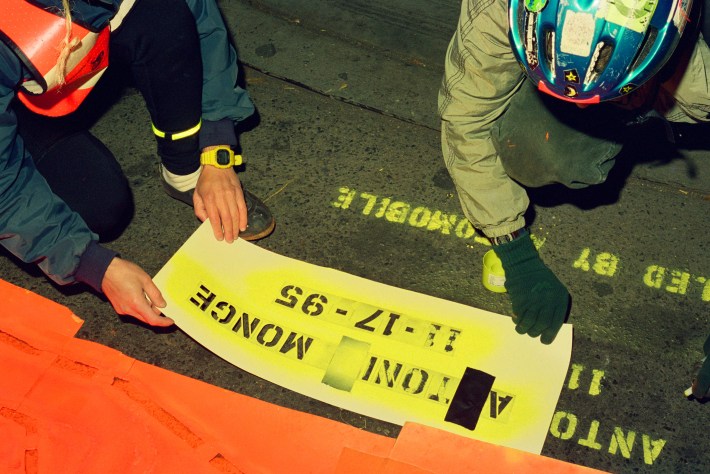
That same night, these urban guerrillas on bikes went around Manhattan similarly marking the places where nine other people were killed by motorists. They have been on this campaign for several months. Their defacing of public property is illegal, but they justify it as answering to a higher call. While that may be debatable, it is hard to argue when they call New Yorkers on foot an embattled species.
Just as we wanted it. We were “urban guerrillas on bikes” but also “pedestrian advocates” acting on behalf of “New Yorkers on foot.” The placement was perfect, too: leading the B section of the establishment organ that ignored pedestrian imperilment — except when the culprits were bicycle-riders.
A few weeks later, the driver of a long-haul commuter bus ran over an NYPD auxiliary lieutenant, a crash covered by the Times as Volunteer Killed on a Street She Protected. The crash, while tragic, had an element of providence: The deceased, Alberta Kenney, was neighbor and friend to Bette Dewing, kvetchmeister columnist for the Upper East Side paper, Our Town.
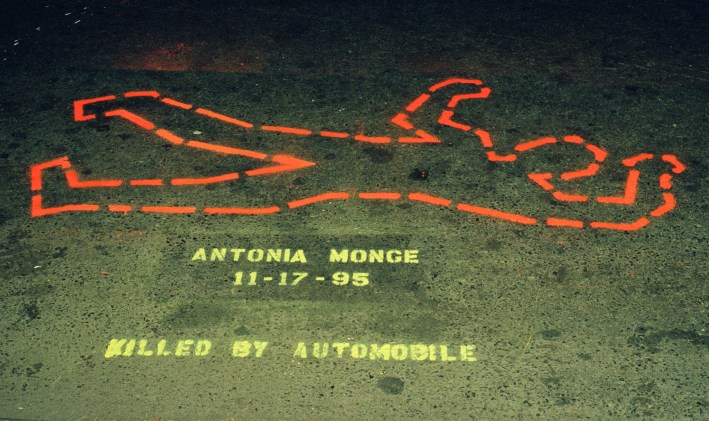
Cyclists had sparred with Dewing for years, branding her ragtag group, Pedestrians First, an antibike front that ignored killer drivers. After Kenney was killed, we routed our next memorial ride to First Avenue and 81st Street, where Dewing gamely held Kenney’s stencil in place as we painted. Thus commenced Dewing’s shift from foe to ally. We would stencil together again, in 2003 and 2014.
Then, in July, Rachel Fruchter, age 57, a living embodiment of intersectional health care as ob-gyn teacher, researcher, caregiver and advocate for underserved communities, was killed when a van driver, operating illegally in Prospect Park on a weekend morning, sped into her bicycle. The night photo of our memorial image, by stenciler Peter Meitzler, haunts me to this day.
Dr. Fruchter’s death sparked a vigil in Prospect Park, where speakers angrily juxtaposed her lifetime of good deeds with the multitude of failings by NYPD and the Parks Department — car entitlement that allowed the van to be driven out of bounds and operated negligently. (My remarks were published later that year in the UK ’zine Bike Culture.) At another vigil a few days later, in City Hall Park, her adult son eloquently expressed his own fury.
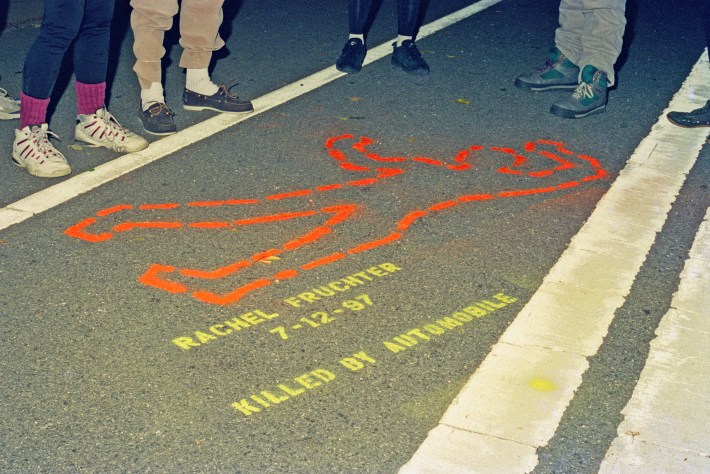
We had the exhilarating sense that our stenciling project was beginning to evoke a movement confronting “traffic violence” as such. Drivers were privileged, unaccountable and deadly. We were fighting back.
When NY Post columnist Andrea Peyser attempted to make a cause célèbre from a delivery cyclist’s fatal crash into a 68-year-old pedestrian on an Upper West Side sidewalk — the city’s first deadly bike-ped collision in several years — one of our founding members, Michael Smith, composed a lacerating account of an eerily similar incident a few weeks later in which a motorist drove onto a sidewalk in East Meadow, Long Island, killing a 68-year-old cyclist.
And when Brooklyn Council Member Noach Dear vowed to block a proposed bike lane through his district, we not only lambasted his parochialism in a Daily News op-ed, Bikes Are Safe, It’s Cars That Kill; we stenciled 15 memorials to pedestrians run over by drivers in his Borough Park redoubt. (Shortly after, we would learn that Dear’s district had the most pedestrian fatalities of any Brooklyn council district.)
That Borough Park foray was made possible through our Freedom of Information Law request for state DMV crash reports of 1994-1997 pedestrian and cyclist fatalities in New York City. At $20 a pop, the nearly one thousand records would have cost us $20,000, but for the free service offered to elected officials. My Council member, Kathryn Freed, proffered the request on our behalf. (A later, supplemental request was tendered by then-Council Member Anthony Weiner, whose brother had been killed by a reckless driver outside Washington, DC.)
Within a month we had several boxes stuffed with 947 computer printouts. Each fatality was represented by a photocopy of its NYPD MV-104a “accident” report along with DMV’s coded distillation indicating proximate cause and, for a minority of cases, legal outcomes. Amazed, we found ourselves with a treasure trove, one we could plumb to determine not just who was being “killed by automobile” in New York City, but how and why.
Come back on Friday for Part III of the series, which focuses on broadening the movement and the message beyond the base.
